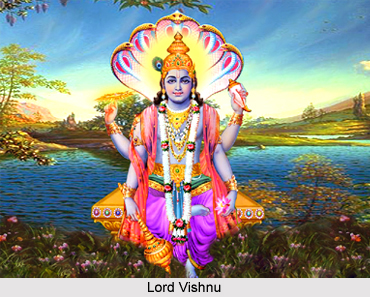 Mahavishnu, a form or aspect of Lord Vishnu in Hinduism, depicts the aspect of the Supreme Reality. The Lord all pervading and beyond all attributes, is the Supreme soul of all living creatures residing in the universe. According to the Vaishnavite theology, Mahavishnu bears resemblance to the Brahma and the Absolute Supreme Personality of Godhead. This signifies that first the Absolute truth is apprehended as a Brahma i.e. the impersonal aspect, later as the Paramatma i.e. the personal aspect and finally as the Lord i.e. incarnate perfection.
Mahavishnu, a form or aspect of Lord Vishnu in Hinduism, depicts the aspect of the Supreme Reality. The Lord all pervading and beyond all attributes, is the Supreme soul of all living creatures residing in the universe. According to the Vaishnavite theology, Mahavishnu bears resemblance to the Brahma and the Absolute Supreme Personality of Godhead. This signifies that first the Absolute truth is apprehended as a Brahma i.e. the impersonal aspect, later as the Paramatma i.e. the personal aspect and finally as the Lord i.e. incarnate perfection.
Mahavishnu resides in the causal ocean or the Karanodak. The Lord installs the seed of the material cosmos in his holy consort, Mahamaya by peeking at her. The deity, subservient in nature, acts to be the ever compliant material power of the Supreme Lord. The natural elements that inculcate fire, water, ether, air and sky are formed along with the mind, the ego and the intelligence.
Upon creating the universe, Mahavishnu penetrates into the diverse elements of the universe created with the aid of the seeds that evolves from the different pores of his skin. In the form of Garbhodaksayi Vishnu the Lord enters the universe and resides in every individual material element. Garbodakshayi Vishnu is thought to reside in all the souls in a collective form in a specific material universe and Mahavishnu is regarded as the collective soul of all souls present in the material universe.
Lord Brahma, the creator of the universe is said to emerge from Garbodakshayi Vishnu.
The ancient temple located in Thrikodithanam in Kerala is one of the five Pancha Pandava temples dedicated to Mahavishnu. This Vaishnavite temple is counted among the 108 temples and celestial abodes of Vishnu.
This article is a stub. You can enrich by adding more information to it. Send your Write Up to content@indianetzone.com




















